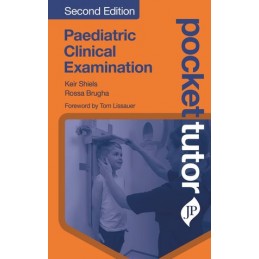- Obniżka


 Dostawa
Dostawa
Wybierz Paczkomat Inpost, Orlen Paczkę, DHL, DPD, Pocztę, email (dla ebooków). Kliknij po więcej
 Płatność
Płatność
Zapłać szybkim przelewem, kartą płatniczą lub za pobraniem. Kliknij po więcej szczegółów
 Zwroty
Zwroty
Jeżeli jesteś konsumentem możesz zwrócić towar w ciągu 14 dni*. Kliknij po więcej szczegółów
Titles in the Pocket Tutor series give practical guidance at a highly-affordable price on subjects that medical students, foundation doctors and a range of other practitioners need help with on the go.
The highly-structured, bite-size content helps novices combat the fear factor associated with day-to-day clinical training, and provides a handy reference that students and junior doctors can carry with them at all times.
Pocket Tutor Paediatric Clinical Examination is an indispensable guide to the examination of children, a challenging part of clinical practice for medical students and junior doctors as it involves dealing with newborn babies through to teenagers (often also the childs parents or guardians) and requires different communication skills and knowledge.
Key features::
Changes to second edition::
Opis
Chapter 1 History taking
1.1 Algorithmic thinking
1.2 Preparation
1.3 Communication
1.4 Components of the paediatric history
1.5 Red Flags
Chapter 2 Examination of a newborn
2.1 Clinical scenarios
2.2 Pregnancy history
2.3 Development and delivery
2.4 Examination of the newborn
Chapter 3 Examination of a child
3.1 Recognising the sick child
3.2 Examining a child
3.3 Chaperones
Chapter 4 Growth and nutrition
4.1 Clinical scenarios
4.2 Common presentations
4.3 Examination of growth
4.4 Examination of pubertal status
4.5 Summary
Chapter 5 Developmental assessment
5.1 Clinical scenarios
5.2 Common presentations
5.2 Developmental milestones
5.3 Developmental assessment
5.4 Summary
Chapter 6 The respiratory system
6.1 Clinical scenarios
6.2 Common presentations
6.3 Respiratory examination
6.4 Summary
Chapter 7 The cardiovascular system
7.1 Clinical scenarios
7.2 Common presentations
7.3 Cardiac examination
7.4 Summary
Chapter 8 The abdomen
8.1 Clinical scenarios
8.2 Common presentations
8.3 Abdominal examination
8.4 Summary
Chapter 9 The nervous system
9.1 Clinical Scenarios
9.2 Common presentations
9.3 Neurological history
9.4 Cranial nerve examination
9.5 Peripheral nerve examination
9.6 Summary
Chapter 10 Bones, joints and muscles
10.1 Clinical scenarios
10.2 Common presentations
10.3 Musculoskeletal examination
10.4 Summary
Chapter 11 The head and neck
11.1 Clinical scenarios
11.2 Common presentations
11.3 Examination of the mouth and throat
11.4 Examination of the ears and nose
11.5 Examination of neck lumps
11.6 Summary
Chapter 12 Skin and rashes
12.1 Clinical scenarios
12.2 Common presentations
12.3 Examination of the skin
12.4 Summary
Chapter 13 Abnormal behaviour
13.1 Clinical scenarios
13.2 Common presentations
13.3 Behavioural examination
13.4 Sleep history and examination
13.5 Summary
Chapter 14 Genetic disorders and syndromes
14.1 Clinical scenarios
14.2 Common genetic syndromes
14.3 Examination for genetic syndromes
14.4 Summary
